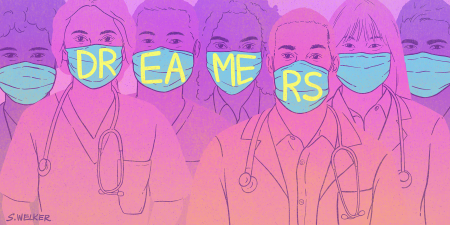Abstract
This article considers intergenerational trauma by drawing on the experience of a 37-year-old Black woman whose great-grandfather died as a result of involuntary involvement in the US Public Health Service Syphilis Study at Tuskegee. Although she never met her great-grandfather, the abuse, exploitation, and human rights violations he suffered at the hands of the US government profoundly influenced her health experiences. This article contextualizes her experiences in light of past medical abuse and microethics.
Intergenerational Trauma
In the United States, the specter of the US Public Health Service (PHS) Syphilis Study at Tuskegee, officially named the Tuskegee Study of Untreated Syphilis in the Negro Male (hereafter referred to as the study), casts a long shadow over biomedical research and medical practice, particularly in relation to Black people and other ethnoracial minorities. The PHS began the study in 1932.1 Approximately 600 poor Black men from Macon County, Alabama, were enrolled in the study. The men were told they would be treated for syphilis when in fact the purpose of the study was to learn whether syphilis progressed differently in Black people than in White people.1 The PHS never intended to provide treatment, and though penicillin was distributed nationally in PHS clinics by 1943,2 the men were not treated. At least 28 and perhaps up to 100 men had died from syphilis or its complications by the time the study was halted in 1972.1 Hundreds went on to infect their wives and children through congenital exposure.2
However, little is known about how the longest continuous study in US medical history might affect the contemporary health and well-being of the study participants’ direct descendants. This case examines the intergenerational impact of the study on the life of T, a 37-year-old Black woman whose great-grandfather died as a result of his involvement in the study. First, we describe T’s experience and argue that physicians and other health care professionals should consider the larger historical context when engaging with Black patients. Second, we analyze how a legacy of medical abuse affects health care decision making for one study descendant in particular and for Black people generally. Finally, the paper provides a brief discussion of microethics—the clinical use of ethical principles in everyday interactions between physicians and patients—and offers suggestions for improving this essential form of health communication.
T’s Experience
When the first author (T.K.S.) met T, she was attending a focus group that T.K.S. ran to learn more about Black women’s health care experience. As she glided into the room wearing a long summer dress, it was immediately clear that she had the youthful bravado of a successful Black woman. As T.K.S. learned during the focus group, although T was the personification of a modern wife—with an MBA and an accounting business—and the mother of 2 children, her experience in the world was shaped by events that took place decades before she was even born.
As T reported to other focus group participants, her family believed that her great-grandfather had died as a result of a botched spinal tap, which had been conducted to determine the stage of his syphilis.3 T described her great-grandfather’s death as just one of a number of a traumatic events her family had experienced at the hands of predominately White institutions, including hospitals, in Alabama. The trauma affected her grandmother, her mother, herself, and her 2 daughters. To adapt to what had occurred decades before T was born, members of her family strictly prohibited her from seeking medical care from White physicians. T noted, “My great-granddad was killed in the Tuskegee experiments, so my mother has a fit if I even seem like I may be seen by a non-Black doctor.” T herself also described being terrified of being treated by a White doctor.
As an adult, T continued her family’s strategy by refusing to allow her children to receive care from White physicians. She described this strategy as a protective one that her family had developed to counteract the particular trauma of the study and the general mistreatment of living under the racial strictures of Jim Crow—particularly, separate and unequal institutions like schools, transportation, and so on. T’s family members had implemented these practices in the hopes of maintaining their own safety and bodily integrity, believing that White physicians might still actively seek to harm them.
How does the legacy of medical abuse, of which Tuskegee is but one example, affect health care decision making for descendants of such abuse?
T recounted an instance in which she took her 11-year-old daughter to the emergency room for abdominal pain, which T thought was caused by food poisoning. Upon learning that her daughter needed emergency surgery for acute appendicitis, she refused to consent to surgery because the hospital did not have a Black surgeon available at the time. Eventually, T explained, her husband insisted that the hospital had to find a Black doctor or a doctor of color. T was fearful of allowing her child to be treated by a White doctor, noting, “I just didn’t want them [White physicians] to cut my child.” Although the hospital eventually located a Black physician to perform the surgery and her daughter recovered without incident, T’s decision to withhold consent for treatment may have had serious consequences. However, given her family history, T felt she had to insist on receiving care from a Black physician.
Historicizing the History and Physical
Although the study has come to represent the specter of medical racism and ethical lapses in research, there is surprisingly little research on the study in relation to “the lived presence of the past,” a phrase the Holocaust scholar Carol Kidron uses to describe the ongoing consequences of past traumas.4 In contrast to the way the Holocaust has been incorporated into our understanding of the overall well-being of survivors and their descendants, the consequences of the study on the lives of Black people in the United States has largely been overlooked. Moreover, much of the research on the study’s implications concerns the Black community’s mistrust of biomedical research but does not specifically address the more proximal implications for study descendants.
T’s family story raises important questions about how (mis)trust of contemporary medicine can contribute to health care disparities. For example, Campos-Castillo and colleagues have noted that trust, or “the willingness to be vulnerable to another party,” varies by race, gender, age, and other demographic factors.5 They found that perceptions of risk and vulnerability characterize patients’ appraisal of trust in health care contexts and, in particular, that ethnoracial minorities, eg, Black and Latinx people, are less likely to trust health care professionals even after controlling for access to health care, social class, and health status.5 And as T’s experience and the empirical literature bear out, the perception of risk of harm is greater among Black women than White women.5
Moreover, social scientists have called for more robust consideration of how historical events affect the present.6 Chowkwanyun has noted that health disparities research lacks historical analysis, which limits knowledge production.6 Ahistorical analyses of social determinants of health might also limit the health care system’s capacity to address the resulting inequities. Through careful consideration of both past and contemporary inequities, we might better understand health behavior and health care decision making. While T’s initial refusal to consent to her child’s surgery might have seemed illogical—or worse, been interpreted as child maltreatment—understanding T’s family history reframes her refusal as a form of protection. In this way, T’s case illustrates the importance of moving beyond explanations of refusal in terms of resistance or noncompliance to medical recommendations.
Microethics, Resistance, and Adherence
T’s story departs from the standard depiction of the study in the context of modern medical ethics, with its emphasis on the Black community’s mistrust of biomedical research. Descendants of the study’s involuntary participants, such as T, interact with the health care system routinely. Moreover, Black people experience inequities in health care, for which clinician prejudice, stereotyping, and bias (both explicit and implicit) have been repeatedly identified as contributing factors,7,8,9,10 as well as disproportionate disease burden and shorter life expectancy.7,8,9,10 Despite widespread attention to health care inequities, little progress has been made in eliminating them.11,12 Thus, the study raises another important ethical question: How does the legacy of medical abuse, of which Tuskegee is but one example, affect health care decision making for descendants of such abuse? And, relatedly, can health care professionals break with centuries of institutionalized, inequitable treatment of Black patients? Can we better understand what happens between a patient and their physician in the context of microethics?
The field of medical ethics refers to this type of immediate and applied ethics as microethics—the clinical use of ethical principles in everyday practice and in interactions between physicians and their patients.13,14 Discussing the work of Komesaroff,15 Guillemin and Gillam contrasted the larger ethical issues typically discussed in the context of research, such as informed consent, with microethics.
By using the term microethics, Komesaroff attempted to capture the everyday ethical issues that arise in clinical practice—the establishment of trust between doctor and patient, the taking of a sexual history, the dealing with past fears, the probing about the patient’s illness experience. None of these presents a “dilemma” in the classic sense … but Komesaroff wanted to both validate them as important ethical matters worthy of the clinician’s attention and also provide a language for reflecting on them.13
Although these routine interactions that occur in the context of medical practice do not present a classical ethical dilemma, they nonetheless challenge health care professionals to create a trusting, safe, and confidential experience for their patients. Other scholars have noted that communication is a key dimension of microethics. For example, Sisk and Baker note: “In every conversation with every family, there are multiple decision points in which word choice, tone, emphasis, and nonverbal cues can affect the family’s understanding, well-being, trust in the clinician, and decision-making process.”16 But navigating these decision points can be quite difficult for clinicians in the predominately White US health system—particularly when iatrophobia, or fear of doctors, is a reasonable adaptation to medical racism.2 Research shows that lack of trust in the patient-clinician relationship can lead to patient disempowerment, less treatment adherence, and worse health outcomes.17,18,19 Moreover, on average, physicians spend less time with Black patients. One study that found that the average length of psychiatric clinic visits with African Americans was several minutes shorter than visits with White patients.20 Thus, we can think of physicians who make the deliberate decision to spend more time with Black patients as engaging in microethical decision making. Although spending more time with patients cannot undo systematic racism or individual-level bias, it can be a critical component of the healing process and is necessary to build rapport and facilitate trust.21,22
Conclusion
This case complicates our understanding of social determinants of health and health care disparities. T’s experience suggests that the factors that contribute to health operate both contemporaneously and over time. In this way, the case highlights the importance of putting the past back into our analysis of contemporary health and social problems. At a time when physicians are asked to take on more and more social responsibilities, they would do well also to learn and acknowledge the history of Black patients’ medical abuse, mistreatment, and marginalization and to understand that mistreatment continues into the present. By situating patients with long histories of mistreatment in the proper context, physicians can better serve them and ultimately reduce health care inequities.
References
- Brandt AM. Racism and research: the case of the Tuskegee Syphilis Study. Hastings Cent Rep. 1978;8(6):21-29.
-
Washington H. Medical Apartheid: The Dark History of Medical Experimentation on Black Americans From Colonial Times to the Present. First Anchor Books; 2006.
-
Jones JH. Bad Blood: The Tuskegee Syphilis Experiment. Free Press/Simon & Schuster; 1993.
- Kidron CA. Toward an ethnography of silence: the lived presence of the past in the everyday life of Holocaust trauma survivors and their descendants in Israel. Curr Anthropol. 2009;50(1):5-19.
-
Campos-Castillo C, Woodson BW, Theiss-Morse E, Sacks T, Fleig-Palmer MM, Peek ME. Examining the relationship between interpersonal and institutional trust in political and health care contexts. In: Shockley E, Neal TMS, PytlikZillig LM, Bornstein BH, eds. Interdisciplinary Perspectives on Trust: Towards Theoretical and Methodological Innovation. Springer International Publishing; 2016:99-115.
-
Chowkwanyun M. The strange disappearance of history from racial health disparities research. Du Bois Rev. 2011;8(1, theme issue):253-270.
- van Ryn M, Burgess DJ, Dovidio JF, et al. The impact of racism on clinician cognition, behavior, and clinical decision making. Du Bois Rev. 2011;8(1, theme issue):199-218.
- Burgess DJ, van Ryn M, Crowley-Matoka M, Malat J. Understanding the provider contribution to race/ethnicity disparities in pain treatment: insights from dual process models of stereotyping. Pain Med. 2006;7(2):119-134.
-
FitzGerald C, Hurst S. Implicit bias in health care professionals: a systematic review. BMC Med Ethics. 2017;18(1):19.
-
van Ryn M, Fu SS. Paved with good intentions: do public health and human service health care professionals contribute to racial/ethnic disparities in health? Am J Public Health. 2003;93(2):248-255.
-
Reverby SM. Examining Tuskegee: The Infamous Syphilis Study and Its Legacy. University of North Carolina Press; 2009.
-
Institute of Medicine. Initial National Priorities for Comparative Effectiveness Research. National Academies Press; 2009.
- Guillemin M, Gillam L. Ethics, reflexivity, and “ethically important moments” in research. Qual Inq. 2004;10(2):261-280.
- Truog RD, Brown SD, Browning D, et al. Microethics: the ethics of everyday clinical practice. Hastings Cent Rep. 2015;45(1):11-17.
-
Komesaroff PA. From bioethics to microethics: ethical debate and clinical medicine. In: Komesaroff PA, ed. Troubled Bodies: Critical Perspectives on Postmodernism, Medical Ethics, and the Body. Duke University Press; 1995:62-86.
- Sisk BA, Baker JN. Microethics of communication-hidden roles of bias and heuristics in the words we choose. JAMA Pediatr. 2018;172(12):1115-1116.
- Valente J, Johnson N, Edu U, Karliner LS. Importance of communication and relationships: addressing disparities in hospitalizations for African-American patients in academic primary care. J Gen Intern Med. 2020;35(1):228-236.
- Netemeyer RG, Dobolyi DG, Abbasi A, Clifford G, Taylor H. Health literacy, health numeracy, and trust in doctor: effects on key patient health outcomes. J Consum Aff. 2020;54(1):3-42.
- Campbell RD, Long LA. Culture as a social determinant of mental and behavioral health: a look at culturally shaped beliefs and their impact on help-seeking behaviors and service use patterns of Black Americans with depression. Best Pract Ment Health. 2014;10(2):48-62.
- Olfson M, Cherry DK, Lewis-Fernández R. Racial differences in visit duration of outpatient psychiatric visits. Arch Gen Psychiatry. 2009;66(2):214-221.
-
Sturmberg JP, Cilliers P. Time and the consultation—an argument for a “certain slowness.” J Eval Clin Pract. 2009;15(5):881-885.
- Street RL Jr, Makoul G, Arora NK, Epstein RM. How does communication heal? Pathways linking clinician-patient communication to health outcomes. Patient Educ Couns. 2009;74(3):295-301.



